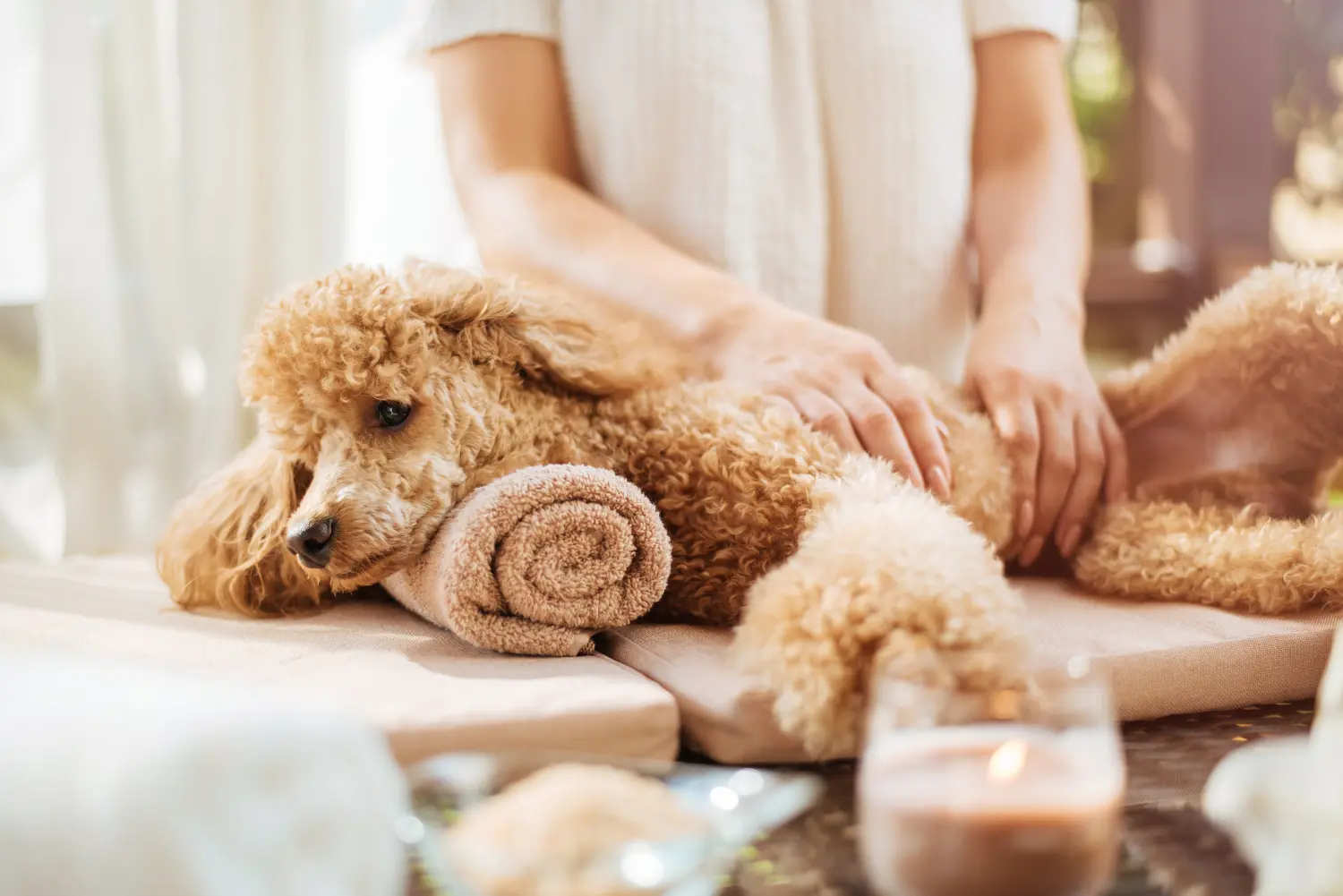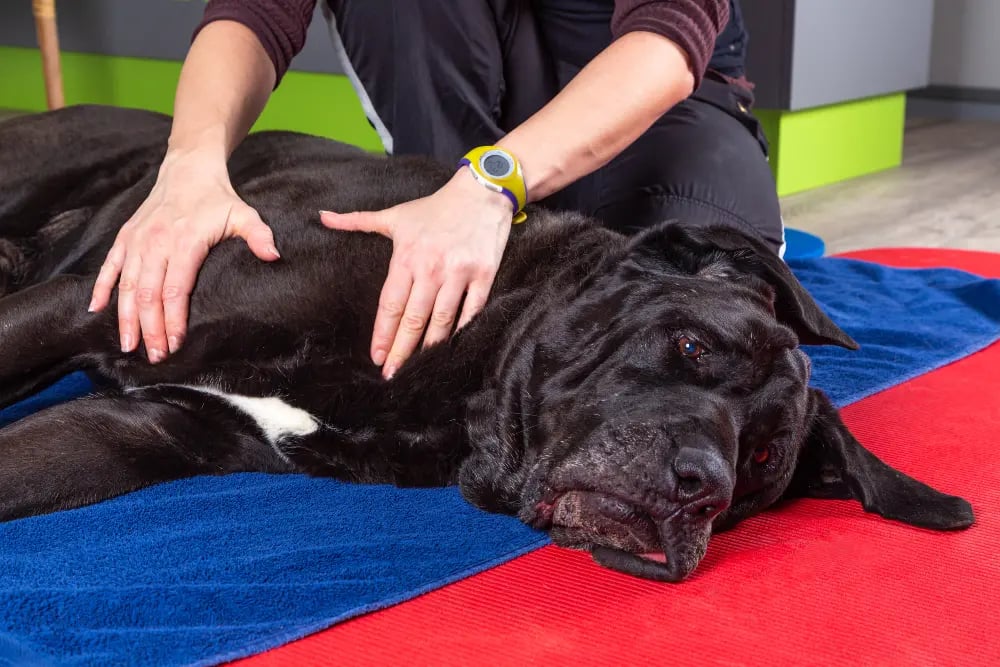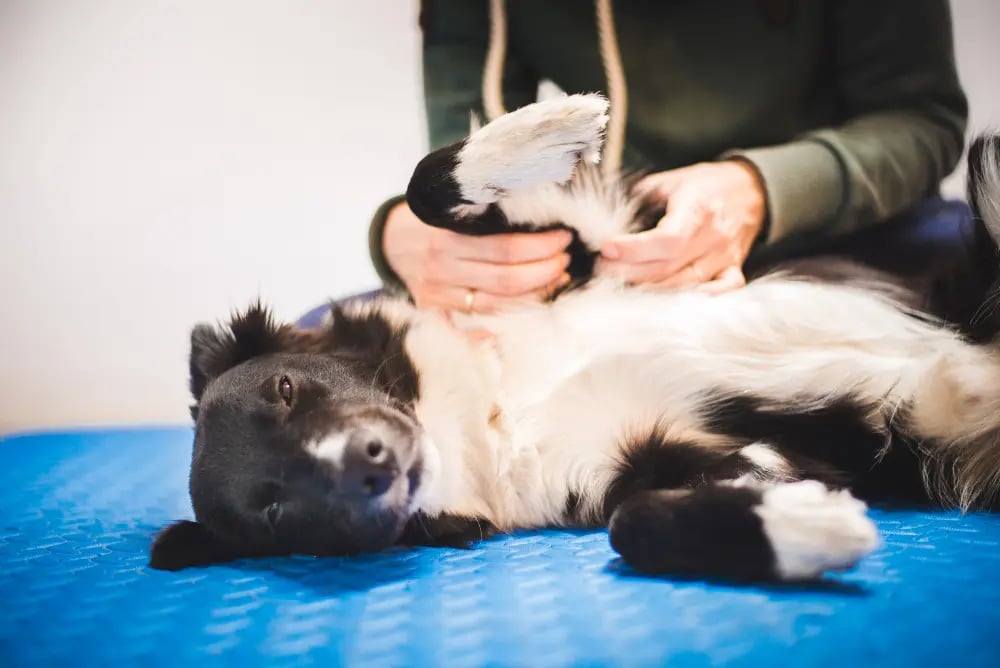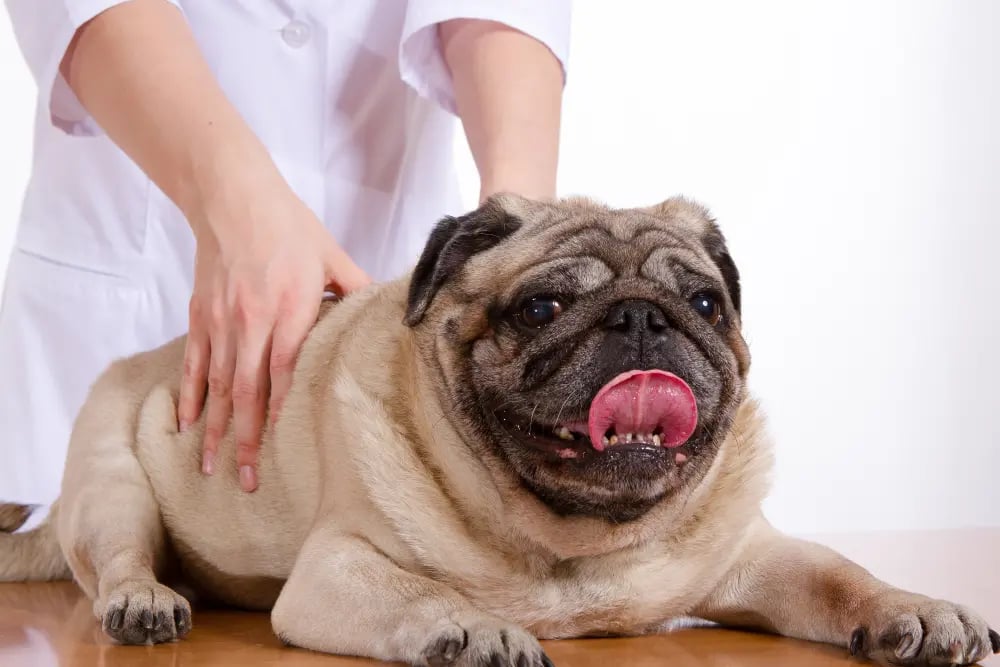
Your dog plays hard, runs fast, and deserves a nice and relaxing massage to help them feel good and stay healthy. Learn some basic tips for dog massage at home and find out how it can help your dog feel amazing!
Dogs are more than just pets - they're loyal companions that provide comfort, love, and companionship. As responsible dog owners, it's our job to limit stress and to ensure that our furry friends are well taken care of, not just in terms of their physical needs but also their emotional well-being.
One way to achieve this is through dog massage, a therapeutic technique that offers a range of benefits for your four-legged friend.
From relieving stress and anxiety to improving joint mobility and circulation, dog massage can help improve the quality of life of your furry companion. In this article, we'll explore the many benefits of dog massage and how it can be incorporated into your dog's wellness routine.
What is Dog Massage Therapy?
Dog massage therapy, also known as canine massage, is a form of hands-on therapy that involves applying gentle pressure and manipulation techniques to the soft tissues and muscles of a dog's body.
Dog massage therapy is beneficial for dogs of all ages and breeds, from puppies to senior dogs. It can help to alleviate the symptoms of many health conditions, such as arthritis, hip dysplasia, muscle strains, and anxiety.
By providing your dogs with the comfort and care they deserve, we can help to enhance their overall health and happiness.
Keep reading to learn beginner techniques and tips for massaging your dog at home and when to leave it to a professional.
Benefits of Dog Massage

Every dog, regardless of ability or age, can benefit from regular massage. At-home dog massages can range from gentle strokes while you are snuggled on the couch to more deliberate techniques to ease tension and stimulate muscles.
You don't have to be a professional to give your
Here are a few ways that your furbaby can benefit from pet massage:
1. Reduces Stress and Anxiety
Just like humans, dogs can experience stress and anxiety, and it can have a negative impact on their health. Regular dog massage can help reduce stress and anxiety in dogs by releasing muscle tension and promoting relaxation. This can lead to improved behaviour and a happier dog.
2. Improves Circulation
Dog massage can help improve circulation by increasing blood flow to the muscles and tissues. This can help improve the delivery of oxygen and nutrients to the cells, which can help reduce inflammation and promote healing.
3. Relieves Pain and Discomfort
Dogs can experience pain and discomfort due to a variety of reasons, such as arthritis, injury, or illness. Massage can help alleviate pain by releasing tension in the muscles and promoting the release of endorphins, which are natural painkillers.
4. Increases Flexibility
Regular massage can help improve flexibility in dogs by reducing muscle tension and increasing the range of motion. This can be especially beneficial for older dogs or dogs with joint problems.
5. Strengthens Bond Between Owner and Dog
Massage can be a great way to bond with your dog and deepen your relationship. It can help build trust and promote relaxation, leading to a stronger bond between you and your furry friend.
How to Massage a Dog
Before you start massaging your dog, it's important to make sure your dog is comfortable. They should be relaxed and capable of sitting or staying relatively still for the duration of the massage. Pick a comfortable spot that is low-traffic and quiet to limit distractions and excitement.
Start by petting your dog gently. Ask them to sit or stay and slowly caress their neck or back. This will allow you to check them for tender spots and look for signs of pain or injury. This can also help you determine the areas of most need.
Basic Dog Massage Techniques
The best at-home dog massage techniques include stroking, kneading, and percussion. This three-step method can be applied no matter what part of your dog's body you are massaging.
Stroking
This technique is a great warm-up for a dog massage. Using the flat palm of your hand, stroke downward using gentle pressure. This technique will stimulate your dog's skin and relax them for the rest of the massage. It's a good idea to both begin and end a massage with this technique.
Kneading
Next, you want to focus on the muscles. Using either your fingertips, the heel of your palm, or your knuckles, you can massage your dog's muscles using circular motions. This will gently pull and push on the muscles to stimulate and loosen them.
Percussion
After kneading, it's helpful to follow up with gentle percussion or tapping techniques. Using a cupped hand or your fingertips, you want to quickly and repeatedly tap your dog, producing a vibration effect. This helps to improve circulation and lymph fluid.
What are the Best Dog Massages?

If you think your dog needs a massage, then you might be wondering where you should focus your massage techniques. Just like people, dogs have many different muscle groups that can benefit from massage.
For general relaxation and to loosen your dog's muscles, you can focus on four main areas:
-
- Dog Back Massage
- Dog Neck Massage
- Dog Leg Massage
- Dog Belly Massage
Each of these areas can benefit from gentle massage and can help to prevent activity-related injury or stiffness, and can help to ease anxiety and improve your bond.
Dog Back Massage Tips
Your dog's back works hard and takes a beating when they play, run, and jump. A weekly back massage can help to relax sore muscles and keep your dog feeling young. Here are a few tips to help you out.
1. Start by placing your hand on your dog's back near the shoulders. With your palm facing down, run your hand down your dog's back to the base of the tail or hips. This can be done from a standing position or a sitting position to give you access to both sides.
2. Avoid placing pressure directly on the spine. Instead, place your palm on the side of the spine and start your strokes, moving further away from the spine with each stroke. Then do the same on the other side.
3. For both kneading and tapping, it may be easier to have your dog lay down on his side. This will make with side and back muscles more accessible, and his spine will be straight and out of the way.
Dog Neck Massage Tips
Your dog's neck also works hard for your dog. If your do loves to play tug of war or loves to grab and shake the life out of his toys, then his neck will get an intense workout. A massage can help to loosen up tight muscles and prevent injury.
1. Your dog's neck massage should start at the base of the skull and work down and out. Use gentle stroking motions first and then circular rubbing motions to reach the muscle tissue.
2. Don't forget your dog's chest. Dogs have plenty of muscles in their chest and shoulders that can get sore after high-energy activities like running or jumping.
3. Your massage can extend to your dog's face too. Using slow twisting stroking motions with the palm of your hand or flat fingers to gently rub your dog's head, behind their ears, their chin, and even their muzzle. This can be incredibly relaxing and is good for anxious or nervous dogs.
Dog Leg Massage Tips
Your dog's leg muscles are vital to their mobility. They support joint health and function and carry the brunt of your dog's mass. Massaging your dog's legs can help to reduce stiffness and encourage circulation to support muscle growth and maintenance.
Unlike their back or torso, the techniques you use to massage your dog's legs will be a little different.
1. Your dog's shoulders are very muscular, so take your time in this area. All three massage techniques can help to keep your dog's shoulders strong and feeling good. Up in the armpit area, use two hands, one on each side of the leg. This will help you apply appropriate pressure to the muscles around the joint.
2. The muscles in your dog's legs, below the shoulder, are thinner, so instead of kneading, you can manipulate the muscle by alternating sets of downward and upward strokes. Uses a gentle squeezing motion to further stimulate muscles.
3. Give your dog a paw massage. If your dog is comfortable with you touching his paws, use your thumb and fingers to gently massage the paw pads in a rolling motion. A very small amount of coconut oil or a paw cream can help to condition the rough pads while you massage.
Dog Belly Massage
A gentle belly massage for dogs can be very relaxing and can also support healthy digestion. This type of dog massage will require a lighter touch and will feel more like you are petting them, but dogs that love a belly rub will also enjoy this massage.
1. This massage is best done with your dog laying on his side or his back. Not all dogs are comfortable laying on their backs, so a side position will do.
2. With your fingers, knead gently with small circular motions. Work your way down to the hips and inner thighs. You can use a gentle pulsing squeezing motion to work the muscles in the thighs and sides of the belly
3. Percussion is a useful tool for helping dogs with gas. After the kneading step, some gentle taps can encourage the expulsion of gas. Aim for soft rapid taps to mimic vibration. Follow up with a few more gentle strokes downward to work out trapped air.
Here's a video to help you get started:
Dog Massage Tips
It’s really easy to get started giving your dog a massage. It's like petting them with a few extra steps. The best way to massage your dog is to watch her reactions, take your time, and enjoy the process.
Here are some great dog massage techniques to help you get started:
1. Start Slow
It's important to start slow and gradually build up to longer massage sessions. This will help your dog become more comfortable with being touched and will help prevent them from becoming overwhelmed.
2. Use Gentle Pressure
Use gentle pressure when massaging your dog, especially when you are first starting out. Too much pressure can cause discomfort and may cause your dog to become anxious.
3. Watch for Signs of Discomfort
Watch for signs that your dog may be uncomfortable, such as panting, licking, or trying to move away. If your dog is uncomfortable, stop the massage and try again later. While most dogs love getting a massage, not all do. Keep in mind that, just like us, dogs have different moods. Try a different time to see if he likes it.
4. Choose a Quiet Environment
Think about your last massage. You probably really enjoyed the quiet atmosphere. Part of getting a massage is relaxing, reducing stimulants, and enjoying the process. Choose a quiet environment for your massage session. This will help your dog relax and will help prevent them from becoming distracted.
5. Use Treats
Reward your puppy for a job well done. Not only does this help relax your pup, but he will trust you more. And who doesn’t love a snack after a massage? Sign us up.
What is Professional Dog Massage Therapy?

Is there such a thing as professional dog massage therapy? Yes, there is! Dog massage therapy is actually more common than you might think.
A professional dog massage therapist is a certified practitioner who provides massage therapy services to dogs. These therapists typically have formal training and education in canine anatomy, physiology, and massage techniques.
They also have a deep understanding of dog behaviour and psychology, which enables them to provide a safe and comfortable environment for their furry clients.
Does My Dog Need a Professional Dog Massage?
Taking your dog to get a professional dog massage is not the same thing as giving your dog a massage at home. While home care is important for relaxing your dog and preventing injury, professional dog massage therapy is geared toward healing.
Dog massage therapy is often recommended for:
- Senior Dogs
- Athletic and Sporting Dogs
- Dogs Recovering from Injury
Dog massage, along with other alternative dog therapies, like acupuncture and chiropractic care, can help to speed up recovery, reduce pain, and improve mobility. Talk to your vet to find out if professional dog massage therapy is right for your pooch.
What's Different About Professional Dog Massages?
During a dog massage therapy session, the therapist will begin by assessing the dog's overall health and any specific issues or concerns.
They will then use a variety of massage techniques, such as effleurage, petrissage, and friction, to gently manipulate the dog's muscles, joints, and soft tissues.
The therapist will also use various tools, such as warm towels, essential oils, and aromatherapy, to enhance the therapeutic effects of the massage.
If you want to provide your dog with the benefits of massage therapy, it is important to choose a certified and experienced dog massage therapist. You should also talk to your veterinarian before beginning any new wellness practice, as they can guide you on the best treatment for your dog's specific needs.
Dog Massage FAQs
Do Dogs Like Massages?
You may be wondering if your dog would even like a massage. The best way to find out is to give it a try! Dog massage therapy is a safe and effective wellness practice that can greatly benefit our furry friends.
Where is it best to massage a dog?
The most muscular spots on your dog can benefit the most from massage. Massaging your dog's shoulders, back, and chest can provide relief from stiffness or soreness after physical exercise. For relaxation, neck and head massages are often very effective too.
How often do dogs need to be massaged?
The frequency of your dog's massages depends on their need. Dogs that are very active might need more frequent massages to reduce pain or discomfort. Most dogs will appreciate a weekly massage, but more frequently is ok as long as you stick to basic techniques.
.png?width=200&height=66&name=logo%20(1).png)

